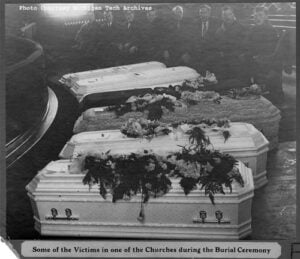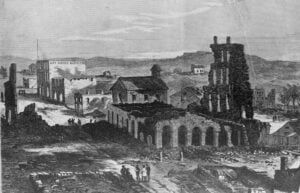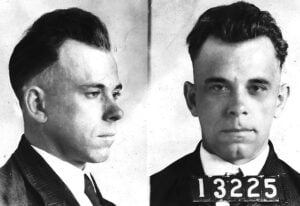Cave-in-Rock and its river pirates
While waves of pioneers floated down the Ohio River, bandits and ruffians lined the banks, waiting to pounce on unsuspecting victims, gifting the Ohio River the nickname the “Bloody River.”

exc-5c23a015aa4a991d870f3e55
In the late 1700s and early 1800s, packing a flatboat in Pennsylvania and floating down the Ohio River was the quickest route to the western frontier. While waves of pioneers floated down the river, Ohio River pirates lined the banks waiting to pounce on unsuspecting victims, gifting the Ohio River the nickname the “Bloody River.”
Flatboats
The average flatboat was forty to seventy feet long and twelve to fifteen feet wide. The deck had a log cabin, with room for wagons and livestock, two oars were attached on the front and back of the boat. Commercial flatboats were loaded with valuables or goods to trade on the Mississippi River.
Ohio River Pirates
The pirates consisted of a variety of rough characters from the east. Veterans of the Revolutionary War, British Loyalists, and fleeing criminals ganged together to prey on passing flat boats.
The river pirates’ methods involved posting one or two people at a prominent place on the bank. They would shout for help. Because passersby would see that these people were lost and underdressed and unprepared for the wilds, they would stop and try to help them. Once they reached the decoys, a gang of men would hop on board robbing and often murdering the crew.
Voyagers had limited maps without mentions of landmarks or navigation tips. Pirates disguised themselves as guides and directed travelers to their hideouts.
Cave-in Rock
In southeast Illinois, there is a cave on the Ohio River. The limestone fissure, Cave-in-Rock, was infamous for its pirates and other outlaws.
The deep cave already had a reputation. Local tribes believed it was a dwelling for evil spirits years before its outlaw history, while its commanding view up and down the Ohio River was unrivaled.
Edmund Flagg, a traveler, journalist, and poet, spent a short time at the Cave in 1836, “The place furnishes a scene of natural beauty worthy an Inman’s pencil” and that “if I mistake not an engraving of the spot has been published: a ferocious-looking personage, pistol in hand, crouched at the entrance, eagerly watching a descending boat.” Flagg said.
Samuel Mason
Samuel Mason, a veteran of the Revolutionary War, made the cave a hangout for his band of outlaws and an inn for unsuspecting travelers. The overnight guests were robbed and murdered if they were carrying anything valuable.
In 1803, he survived a gunshot to the head, only to be decapitated by his gang. The Ohio River pirates wrapped his head in clay for preservation, so they could accept the bounty over his head.
Harpe brothers: Serial killers of the river
The most violent of the outlaws were two men known as the Harpe brothers. Even their ruthless gang members were shocked by their deeds and in a nine-month period they were suspected of murdering 40 people. The men had quote
“A savage thirst for blood – a deep-rooted enmity against human nature, could alone
be discovered in their actions . . . Plunder was not
their object; they took only what would have been
freely given them, and no more than what was necessary
to supply the immediate wants of nature ; they destroyed
without having suffered injury, and without the prospect of benefit . . . Mounted on fine horses they
plunged into the forest, eluded pursuit by frequently
changing their course, and appeared unexpectedly to perpetrate new horrors, at points distant from those
where they were supposed to lurk.”
Before their residency at Cave-in-rock, they were infamous for murdering women and children throughout Tennessee and Kentucky, and suspected for setting fire to a number of houses and stables.
One story states…
“A flatboat had come down the river and its passengers, not realizing they were near the famous rendezvous of outlaws, landed about a quarter of a mile above the Cave at the foot of a small bluff, later known as Cedar Point. Among the travelers on board were a young man and his sweetheart who, while their companions were making some repairs to the boat, strolled to the top of the cliff and there sat down upon a rock. The view from that point is still beautiful and was probably even more so in primeval days. While the two lovers were sitting on the edge of the cliff with their backs to the wild woods behind them, leisurely considering the landscape, or the life before them, the two Harpes quietly approached from the forest and, without a word of warning, pushed the lovers off the cliff. They fell on a sandy beach forty feet below and, to the surprise of all, escaped unhurt. The Harpes returned to the Cave, and, as already stated, boasted, but without the expected effect, of the prank they had played.”
The Harpes also supposedly stripped a man naked, tied him to the back of the horse, and forced the horse to run off the cliff.
The Harpes were eventually murdered by their own gang. Similar to the Mason story, there are reports of the gang decapitating one of the Harpes with Harpe’s own butcher knife.
Jim Wilson
Around 1809, a storm forced Jim Wilson towards the cave. He took notice of the dry ceilings and sanded floors, and the following spring, he brought his family and stockpiles of stolen liquor and guns to the cave. Like Mason, he put up a sign upriver that said “’Wilson’s Liquor Vault and House for
Entertainment.”
Rum-loving boat crews would stop at the improvised inn. It became a debaucherous hub for gamblers and thieves. Each boat that landed was captured by the inhabitants of the cave. The crew members were given a choice. They could join the gang, or they could float away towards nearby Hurricane Island. The voyagers that made the latter choice were captured further down the river, brutally murdered, and tossed into the river.
The decline of the pirates:
In the east, people started to notice that loved ones, crew members, and cargo were disappearing. Travelers started traveling in flotillas armed with one-pound cannons and skilled sharpshooters.
As the West piqued interest in more and more pioneers, the outlaws were overwhelmed by the sheer amount of brave pioneers.
Eventually, the flatboats were replaced by more efficient steamboats.
Today, Cave-in-Rock is a state park. Tourists can see years of graffiti from the outlaws.
Sources:
http://tripsintohistory.com/2012/05/22/high-piracy-on-the-ohio-and-mississippi-rivers/
http://www.chartiers.com/raybell/1995-mason.html
https://www.loc.gov/resource/lhbtn.1595a/?sp=3
http://www.illinoishistory.com/harpes.html
https://ia800303.us.archive.org/4/items/outlawsofcaveinr00roth/outlawsofcaveinr00roth.pdf






1 thought on “Cave-in-Rock and its river pirates”